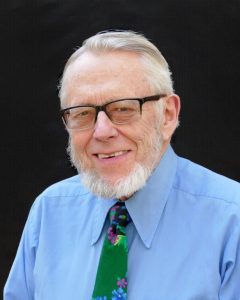MORGANTOWN — Plants have been George Longenecker’s life and a hobby for a long time — probably as long ago as when he was in fourth grade.

His father, a landscape architect, planted wildflowers in the family’s yard and Longenecker learned to identify them with pictures. Soon his fourth-grade teacher learned about his interest, and the youngsters first teaching experience was teaching his classmates about the flowers in his yard.
He was a senior in high school when he announced to his parents and best friend, at the dinner table, that he was going into landscape architecture. He had made up his mind and it never changed.
In May, he won an Award of Excellence from the National Garden Clubs Inc. He said it’s always nice to be recognized and appreciated for the work he’s done. Over the years, he’s kept in touch with many past students and they always tell him they appreciate what he’s done for them as a teacher.
The landscape architecture program started at WVU in 1965. He came to the university in the fall of 1966 and helped build the program by getting course outlines approved by the University Senate.
As a teacher for 39 years, a majority of his coursework revolved around plants, but he also taught the first computer class in the program. He said he had to buy his own computer.
As a professor at WVU, he liked to take the students out to look at flowers, instead of just studying pictures. See plants on campus was OK for a couple of weeks, but he wanted the students to see more. They looked at plants in the Evansdale area, and wandered around in yards in Suncrest.
“It got me to realize, you know, it would be nice if the students had a place so they could study plants,” he said.
His idea to start a botanic garden was born. He knew the WVU Core Arboretum had a lot of plants, but most were native.
“From the standpoint of landscape architecture, we need to look at the fundamental qualities of plants and the use in residential, park landscapes and that type of thing,” he said.
Back in the ’80s he was talking with many people about doing an Arboretum for fundamentals. Many questioned why the community needed two Arboretums.
“The other thing we found is a lot of people don’t know how to spell Arboretum,” he said.
He with the name West Virginia Botanic Garden, Longenecker said, because it was representative of more than Morgantown. The organization became a nonprofit, and in the late 90s the West Virginia Botanic Garden Inc. took possession of land at Tibbs Run. It continues to be a popular outdoor attraction.
He said many people don’t realize it, but architecture isn’t just about buildings, but landscape architects deal with the spaces between buildings.
Whether its pavement, patios or plants — students need to have a good knowledge of ecology to make sure what they’re doing fits the site. That’s not limited to soils, drainage, sun and wind patterns, but basically anything that has to do with the outdoors.
“One of the things I often tell people is architecture is three-dimensional design and landscape architecture is four-dimensional design,” he said.
He said people will often ask, “what do you mean by that?”
“The fourth dimension is time. When you plant the plant it’s going to grow, it’s going to change the spatial qualities more. You have to think of it through the seasons … You have to think what’s it going to be like 20 years down the road once you plant it,” he said.
Though Longenecker retired in 2005 he’s still involved in the field. He goes to Fallingwater, one of the houses designed by Frank Lloyd Wright, and works with landscape architecture interns. He said it’s always fun to work with students and he thinks it helps keep him young.
“One of the things I always felt lucky about in teaching landscape architecture, particularly teaching the courses on plants, most people when they have a job, they do what they do on the job — they do something else when they get home. My situation was that my work and my hobby were the same thing,” he said.



